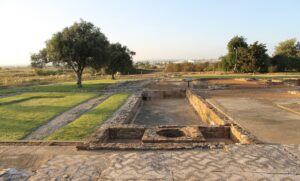
As the Algarve prepares for a gradual easing of international travel restrictions, the region’s premier attractions have been taking the opportunity to upgrade their facilities and services. One that has just re-opened after a pre-summer makeover is Cerro da Vila Museum and Archaeological Site, which is listed among the top-10 places to visit during a trip to Portugal’s popular southern coastal region.
Located adjacent to the Vilamoura residential and leisure resort, the site offers an engrossing 5,000-year journey through history, including the Roman (c. 1st-5th AD) and Islamic (c. 8th-12th AD) periods. Many of the artefacts – relating to architecture, sculpture, commerce and funerals – are believed to be unique in Portugal.
The Algarve’s Roman Empire past is highlighted by a route that immerses visitors in the remnants of a typical maritime villa. Inside are mosaics, luxurious fountains (domus), public and private baths, fish sauce factories and funerary monuments (columbaria, inhumation graves), while the site also showcases the existence of a fluvial port serving as a trading post.
 The museum visit begins with an on-site appreciation of graves unearthed in Vilamoura’s Vinha do Casão cemetery (circa 12th-10th BC), dating to an era in the southern Iberian peninsula when the local economy was focused on the exploration and production of bronze metal.
The museum visit begins with an on-site appreciation of graves unearthed in Vilamoura’s Vinha do Casão cemetery (circa 12th-10th BC), dating to an era in the southern Iberian peninsula when the local economy was focused on the exploration and production of bronze metal.
Suitable for families, the Cerro da Vila Museum and Archaeological Site offers fascinating insights into the Algarve’s history, in the heart of a major resort area where tourists can also enjoy a diverse array of 21st century cosmopolitan attractions. These include the largest marina in Portugal, just a five-minute walk from the historical site.
Established more than 50 years ago, the Vilamoura destination comprises championship golf courses, international equestrian facilities, other nautical and land-based sports, several spas, two beaches, over 100 restaurants, a casino and chic bars and beach clubs, as well as the Vilamoura Environmental Park.
